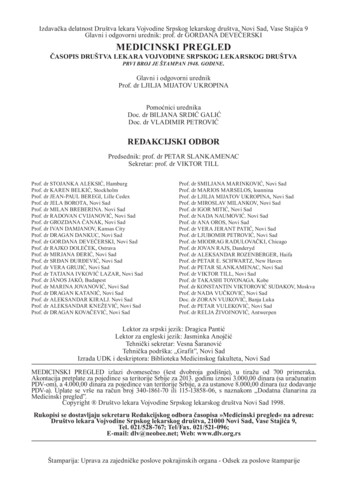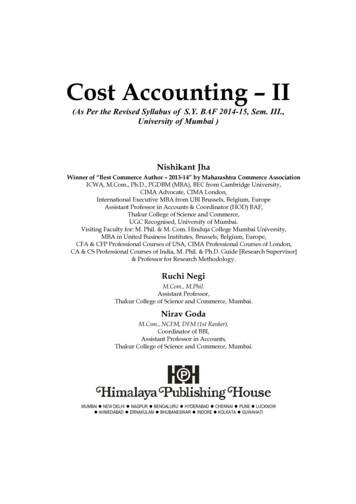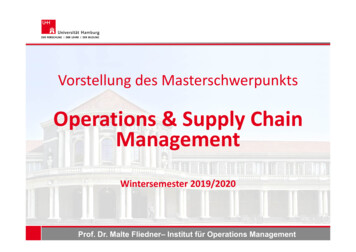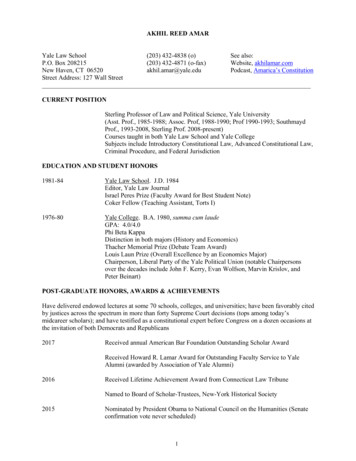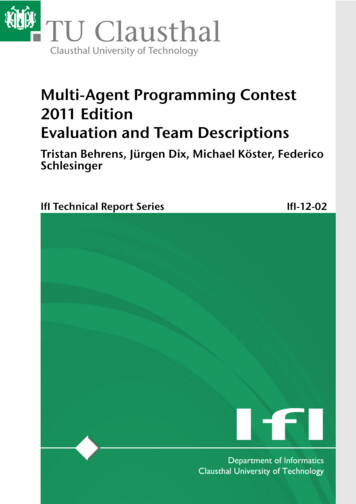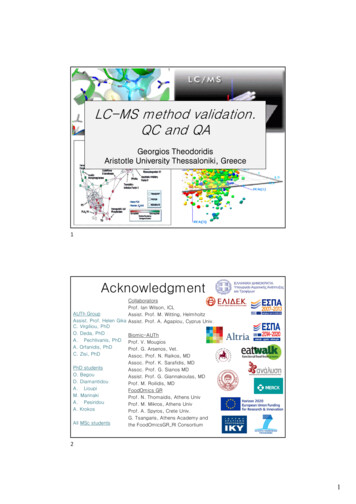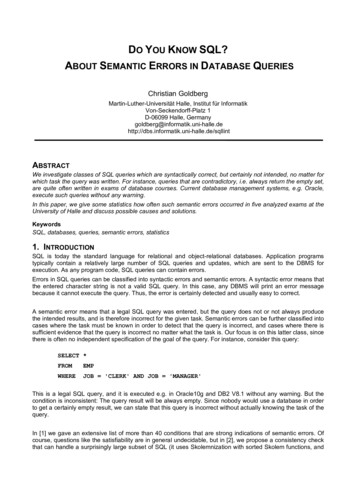
Transcription
LOGISTICS ANDSUPPLY CHAIN MANAGEMENT(As per the Revised Syllabus 2016-17 of Mumbai University for T.Y.BMS, Semester V)Prof. K. SHRIDHARA BHATB.E. (Mech.), PG DIM, M.B.A., F.I.I.M.M.Managing Director,Akshaya Management Consultancy Services,Bangalore - 560 085,Karnataka, India.ISO 9001:2008 CERTIFIED
(ii) AuthorNo part of this publication may be reproduced, stored in a retrieval system, or transmitted in any form or by any means,electronic, mechanical, photocopying, recording and/or otherwise without the prior written permission of the publishers.First Edition : 2016Published by: Mrs. Meena Pandey for Himalaya Publishing House Pvt. Ltd.,“Ramdoot”, Dr. Bhalerao Marg, Girgaon, Mumbai - 400 004.Phone: 2386 01 70/2386 38 63, Fax: 022-2387 71 78Email: himpub@vsnl.com Website: www.himpub.comBranch OfficesNew Delhi: “Pooja Apartments”, 4-B, Murari Lal Street, Ansari Road, Darya Ganj,New Delhi - 110 002. Phone: 011-23270392, 23278631; Fax: 011-23256286Nagpur: Kundanlal Chandak Industrial Estate, Ghat Road, Nagpur - 440 018.Phone: 0712-2738731, 3296733; Telefax: 0712-2721216Bengaluru: Plot No. 91-33, 2nd Main Road, Seshadripuram, Behind Nataraja Theatre,Bengaluru - 560020. Phone: 08041138821, 9379847017, 9379847005Hyderabad: No. 3-4-184, Lingampally, Besides Raghavendra Swamy Matham, Kachiguda,Hyderabad - 500 027. Phone: 040-27560041, 27550139Chennai: New-20, Old-59, Thirumalai Pillai Road, T. Nagar, Chennai - 600 017.Mobile: 9380460419Pune: First Floor, “Laksha” Apartment, No. 527, Mehunpura, Shaniwarpeth(Near Prabhat Theatre), Pune - 411 030. Phone: 020-24496323/24496333;Mobile: 09370579333Lucknow: House No 731, Shekhupura Colony, Near B.D. Convent School, Aliganj,Lucknow - 226 022. Phone: 0522-4012353; Mobile: 09307501549Ahmedabad: 114, “SHAIL”, 1st Floor, Opp. Madhu Sudan House, C.G. Road, Navrang Pura,Ahmedabad - 380 009. Phone: 079-26560126; Mobile: 09377088847Ernakulam: 39/176 (New No: 60/251) 1st Floor, Karikkamuri Road, Ernakulam,Kochi – 682011. Phone: 0484-2378012, 2378016 Mobile: 09387122121Bhubaneswar: 5 Station Square, Bhubaneswar - 751 001 (Odisha).Phone: 0674-2532129, Mobile: 09338746007Kolkata: 108/4, Beliaghata Main Road, Near ID Hospital, Opp. SBI Bank,Kolkata - 700 010, Phone: 033-32449649, Mobile: 7439040301Typeset by: Page Designers, BengaluruPrinted at: Rose Fine Art, Mumbai. On behalf of HPH.
(iii)PrefaceSupply Chain Management has become an essential aspect of business today. It comprisesthe application of the total systems approach to managing the entire flow of information, materialsand services from the raw material suppliers through production and distribution centres to theend customers. It includes all the processes that add value to material and bring the finalproduct to the customers.Logistics is concerned with getting products and services where they are needed and whenthey are desired. It involves the integration of information, transportation, inventory, warehousing,materials handling and packaging.Logistics Management is that part of Supply Chain Management that plans, implements andcontrols the efficient and effective forward and reverse flow and storage of goods, services andrelated information between the point of origin and the point of consumption in order to meet customerrequirements.Logistics and Supply Chain Management are closely related aspects which have been integratedand developed as a proven business strategy to meet the increasing customer demands for quality,delivery and speed. Logistics and Supply Chain Management are necessary cornerstones ofcompetitive strategy, increased market share and shareholder value for most organisations in the 21stcentury.The present era is the era of “supply chain competition”. There is a need to create “valuedelivery systems” that are more responsive to fast changing markets. The entire supply chain i.e.,the value delivery systems must be focused on the achievement of the needed objectives and goalsto compete successfully.This book is organized into four modules, each module consisting of four units, thereby having16 units (or chapters) in total. It covers the syllabus of BMS degree program of University ofMumbai. However, this book is useful for students of graduate or post-graduate degree or diploma inBusiness Management or Logistics and Supply Chain Management of any other Indian Universityas well.K. SHRIDHARA BHATNo. 680, ‘Akshaya’, 1 ‘C’ Main,Kempegowda Layout, 3rd Block,3rd Phase, Banashankari III Stage,Bangalore - 560 085.Phone: (080) 26694761Email: sbhat680@yahoo.com
(iv)AcknowledgmentI sincerely thank Sri Niraj Pandey and Sri Anuj Pandey of Himalaya Publishing House,Pvt. Ltd., for showing interest to publish this book.I thank Sri B.S. Madhu of M/S Page Designers for the effort in completing the DTP workin a very short time.I thank Smt. Nimisha and staff of HPH production unit for printing the book and for theircover page design.I invite readers – both students and faculty members to offer their valuable suggestions toimprove the book in its future editions.– K. Shridhara Bhat
(v)SyllabusBachelor of Management Studies Programme at Semester Vwith effect from the Academic Year 2016-2017Course Code: UBMSFSV.1Logistics and Supply Chain ManagementModules at a GlanceSr.No.ModulesNo. ofLectures1Overview of Logistics and Supply Chain Management152Elements of Logistics Mix153Inventory Management, Logistics Costing, Performance Managementand Logistical Network Analysis15Recent Trends in Logistics and Supply Chain Management15Total604ObjectivesSr.No.Objectives1To provide students with basic understanding of concepts of logistics and supply chainmanagement2To introduce students to the key activities performed by the logistics function3To provide an insight into the nature of supply chain, its functions and supply chainsystems4To understand global trends in logistics and supply chain management
(vi)Sr.No.Modules/Units1Overview of Logistics and Supply Chain Management(a) Introduction to Logistics Management Meaning, Basic Concepts of Logistics–Logistical Performance Cycle, InboundLogistics, Inprocess Logistics, Outbound Logistics, Logistical Competency,Integrated Logistics, Reverse Logistics and Green Logistics Objectives of Logistics, Importance of Logistics, Scope of Logistics, LogisticalFunctions/Logistic Mix, Changing Logistics Environment(b) Introduction to Supply Chain Management Meaning, Objectives, Functions, Participants of Supply Chain, Role of Logistics inSupply Chain, Comparison between Logistics and Supply Chain Management,Channel Management and Channel Integration(c) Customer Service: Key Element of Logistics Meaning of Customer Service, Objectives, Elements, Levels of Customer Service,Rights of Customers(d) Demand Forecasting Meaning, Objectives, Approaches to Forecasting, Forecasting Methods, ForecastingTechniques, (Numerical on Simple Moving Average, Weighted Moving Average)2Elements of Logistics Mix(a) Transportation Introduction, Principles and Participants in Transportation, Transport Functionality,Factors Influencing Transportation Decisions, Modes of Transportation–Railways,Roadways, Airways, Waterways, Ropeways, Pipeline, TransportationInfrastructure, Intermodal Transportation(b) Warehousing Introduction, Warehouse Functionality, Benefits of Warehousing, WarehouseOperating Principles, Types of Warehouses, Warehousing Strategies, FactorsAffecting Warehousing(c) Materials Handling Meaning, Objectives, Principles of Materials Handling, Systems of MaterialsHandling, Equipments Used for Materials Handling, Factors Affecting MaterialsHandling Equipments(d) Packaging Introduction, Objectives of Packaging, Functions/Benefits of Packaging, DesignConsiderations in Packaging, Types of Packaging Material, Packaging Costs
(vii)Sr.No.Modules/Units3Inventory Management, Logistics Costing, Performance Measurement andLogistical Network Analysis(a) Inventory Management Meaning, Objectives, Functions, Importance, Techniques of Inventory Management(Numericals – EOQ and Reorder Levels)(b) Logistics Costing Meaning, Total Cost Approach, Activity Based Costing, Mission Based Costing(c) Performance Measurement in Supply Chain Meaning, Objectives of Performance Measurement, Types of PerformanceMeasurement, Dimensions of Performance Measurement, Characteristics of IdealMeasurement System(d) Logistical Network Analysis Meaning, Objectives, Importance, Scope, RORO/LASH4Recent Trends in Logistics and Supply Chain Management(a) Information Technology in Logistics Introduction, Objectives, Role of Information Technology in Logistics and SupplyChain Management, Logistical Information System, Principles of LogisticalInformation System, Types of Logistical Information System, Logistical InformationFunctionality, Information Technology Infrastructure(b) Modern Logistics Infrastructure Golden Quadrilateral, Logistics Parks, Deep Water Ports, Dedicated FreightCorridor, Inland Container Depots/Container Freight Stations, Maritime Logistics,Double Stack Containers/Unit Trains(c) Logistics Outsourcing Meaning, Objectives, Benefits/Advantages of Outsourcing, Third Party LogisticsProvider, Fourth Party Logistics Provider, Drawbacks of Outsourcing, Selectionof Logistics Service Provider, Outsourcing – Value Proposition(d) Logistics in the Global Environment Managing the Global Supply Chain, Impact of Globalization on Logistics and SupplyChain Management, Global Logistics Trends, Global Issues and Challenges inLogistics and Supply Chain Management
(viii)Question Paper PatternDuration: 2.5 HoursN.B:75 Marks5 questions of 15 marks each.All questions are compulsory.Q.1. Attempt any two:15 Marks(a)(b)(c)Q.2. Attempt any two:15 Marks(a)(b)(c)Q.3. Attempt any two:15 Marks(a)(b)(c)Q.4. Attempt any two:15 Marks(a)(b)(c)Q.5 Case Study15 Marks
(ix)ContentsMODULE 1 : OVERVIEW OF LOGISTICS AND SUPPLY CHAIN MANAGEMENTUNIT 1 : INTRODUCTION TO LOGISTICS 121.131.14IntroductionWhat is Logistics?What is Logistics Management?Concepts of LogisticsLogistics Performance CycleStages of LogisticsLogistical CompetencyIntegrated LogisticsReverse LogisticsGreen LogisticsObjectives of Logistics ManagementScope and Importance of Logistics ManagementLogistical Functions/Logistics MixThe Changing Logistics EnvironmentReview QuestionsUNIT 2 : INTRODUCTION TO SUPPLY CHAIN uctionWhat is a Supply Chain?What is Supply Chain Management?Importance of Supply Chain ManagementObjectives of Supply Chain ManagementFunctions of Supply Chain ManagementParticipants of Supply ChainRole of Logistics in Supply Chain ManagementDifference between Logistics Management and Supply Chain ManagementChannel Management and Channel IntegrationReview QuestionsUNIT 3 : CUSTOMER SERVICE: KEY ELEMENTS OF LOGISTICS3.03.13.23.33.43.53.63.7IntroductionWhat is Customer Service?Objectives/Goals of Customer ServiceLevels of Customer ServiceDimensions or Elements of Customer ServicePerformance Measures for Customer ServiceRight of CustomersReview Questions1 - 181234567789111214151719 - 46191921222324353637384647 - 554747485051525455
(x)UNIT 4 : DEMAND and ForecastingObjectives of Demand ForecastingBasic Approach to Demand ForecastingForecasting MethodsForecasting TechniquesSolved ProblemsReview Questions56 - 675656585860616667MODULE 2 : ELEMENTS OF LOGISTICS MIXUNIT 5 : TRANSPORTATION5.05.15.25.35.45.5IntroductionThe Role of Transportation in a Supply ChainTransportation Functionality, Principles and ParticipantsFactors Influencing Transporation DecisionsTransportation InfrastructureReview QuestionsUNIT 6 : WAREHOUSING6.06.16.26.36.46.56.66.7IntroductionThe Warehousing FunctionBenefits of WarehousingWarehousing PrinciplesTypes of WarehousesWarehousing StrategyFactors Affecting WarehousingReview QuestionsUNIT 7 : MATERIALS oductionDefinitions of Materials HandlingFunctions of Materials HandlingImportance of Materials HandlingObjectives of Materials HandlingMaterials Handling PrinciplesClassification of Handling SystemsTypes of Materials Handling SystemsTypes of Materials Handling EquipmentsFactors Influencing Materials Handling SystemsFactors Affecting Selection of Materials Handling EquipmentsReview QuestionsUNIT 8 : PACKAGING8.08.18.2IntroductionObjectives of PackagingFunctions of Packaging68 - 7968687173767980 - 109808086889096107108110 - 124110110111111112112113115116119123124125 - 132125126126
(xi)8.38.48.58.68.7The Role of Packaging in WarehousingPackaging DesignTypes of Packaging MaterialsPackaging CostsReview Questions128128130131132MODULE 3 : INVENTORY MANAGEMENT, LOGISTICS COSTING, PERFORMANCEMEASUREMENT AND LOGISTICAL NETWORK ANALYSISUNIT 9 : INVENTORY ntory Management BasicsObjectives of Inventory ManagementFunctions of Inventory ManagementImportance of Inventory ManagementTechniques of Inventory ManagementInventory Control SystemsReview QuestionsUNIT 10 : LOGISTICS nLogistics CostsLogistics CostingTotal Cost ConceptTotal Cost AnalysisPrinciples of Logistics CostingActivity-Based Management (ABM)Review QuestionsUNIT 11 : LOGISTICS PERFORMANCE roductionObjectives of Performance MeasurementTypes of Performance MeasuresInternal versus External Performance MeasurementDimensions of Performance MeasurementCharacteristics of Good MeasuresGuidelines for Logistics and Supply Chain PerformanceDeveloping and Implementing Performance Measurement SystemsReview QuestionsUNIT 12 : LOGISTICAL NETWORK ANALYSIS12.012.112.212.312.412.5IntroductionSupply Chain NetworksLogistics/Supply Chain Network DesignLogistics/Supply Chain Network Design ProcessModeling Approaches to Logistics/Supply ChainReview Questions133 - 149133133136137138139145149150 - 159150150151152153156157159160 - 167160161161162164164165166167168 - 189168168169171174189
(xii)MODULE 4 : RECENT TRENDS IN LOGISTICS AND SUPPLY CHAIN MANAGEMENTUNIT 13 : INFORMATION TECHNOLOGY IN ductionObjectives of Information Technology in LogisticsThe Role of Information Technology in a Supply ChainLogistics Information SystemsPrinciples of Logistics Information SystemsTypes of Logistical Information SystemsLogistical Information FunctionalityLogistics/Supply Chain Information TechnologiesReview QuestionsUNIT 14 : MODERN LOGISTICS 14.914.1014.12IntroductionGolden Quadrilateral – A Highway NetworkLogistics parksIndian Shipping IndustryDedicated Freight CorridorsInland Container Depot (ICD)Marine Logistics (Maritime Logistics)ContainerisationDouble Stack Container Trains/Unit TrainsContainer Corporation of IndiaPrivate Logistics Companies in IndiaReview QuestionsUNIT 15 : LOGISTICS roductionMeaning of Logistics OutsourcingObjectives of Logistics OutsourcingBenefits of Logistics OutsourcingThird Party and Fourth Party Logistics ProvidersDrawbacks of OutsourcingSelection of Logistics Service ProviderOutsourcing Value PropositionReview QuestionsUNIT 16 : LOGISTICS IN GLOBAL ENVIRONMENT16.016.116.216.316.416.5IntroductionThe Concept of Global Logistics and Global Supply ChainsGlobal/International Logistics and Supply Chain ManagementGlobal Logistics TrendsGlobal Issues and Challenges in Logistics and Supply Chain ManagementReview Questions190 - 205190192192194196197198201205206 - 220206210211211212212213214215217217219221 - 232221221222222223228229230232233 - 246233233238240244246CASE STUDIES245 - 251INDEX252 - 256
MODULE 1 : OVERVIEW OF LOGISTICS AND SUPPLY CHAIN MANAGEMENTUNIT 1Introduction to Logistics Management1.0 INTRODUCTIONLogistics is concerned with getting products and services where they are needed and whenthey are desired. In a modern society, most of the customers and consumers take excellent logisticsservice as granted and tend to notice logistics only when there is a problem, for example,non-availability of goods and services they need very badly. When consumers go to the retail stores,they expect products to be available in good condition, for example, fresh fruits, meat, vegetablesand the like. It is difficult to visualise accomplishing any manufacturing and marketing activityefficiently and effectively without logistical support. Logistics is a broad, far-reaching function,having a great impact on the standard of living of a modern society.To understand some of the implications of logistics activity to consumers, we may considerthe following:(i) The difficulty of consumers in shopping for food, clothing and other items in one place(super bazaar or retail shop) if logistical systems do not bring all these items together inone place.(ii) The problem in locating the proper size or style of an item (say shoes or ready madegarments) if logistical systems fail to provide a wide product-mix, colours, sizes and stylesthrough the assortment process.(iii) The frustration for consumers when they go to a store to purchase an advertised item andfind out that the item has not arrived at the store yet.The issues mentioned above illustrate how logistics affects many facets of the daily lives ofconsumers and the impact it has on individuals and the society.Logistics involves the integration of information, transportation, inventory, ware-housing,materials handling and packaging. The operating responsibility of logistics is the geographicalpositioning of raw materials, work-in-process, and finished goods inventories where required at thelowest cost possible. Logistical process facilitates the flow of materials from suppliers to themanufacturing firms and the distribution of finished products through marketing channels toconsumers. The complexity of logistics increases with the number of industrial manufacturers,suppliers, and the channel intermediaries such as wholesalers, distributors and retailers within a1
2Logistics and Supply Chain Managementnation. The complexity of logistics becomes awesome when we consider business on a global basis,having global manufacturers, global suppliers and global consumers.1.1 WHAT IS LOGISTICS?Logistics is defined as the process of anticipating customer needs and wants, acquiring thecapital, materials, people, technologies, and information necessary to meet those needs andwants, optimising the goods or service — providing network to customer requests and utilisingthe network to fulfil customer requests in a timely manner.Box 1.1 lists the various perspectives of the definitions of Definition(i) InventoryManagement of materials in motion and at rest.(ii) CustomerGetting the right product to the right customer, in the right quantity, inthe right condition, at the right place, at the right time and at the rightcost. (referred to as the seven ‘r’s of logistics)(iii) DictionaryThe branch of military science having to do with processing, maintainingand transporting materials, personnel and facilities.(iv) International Societyof LogisticsThe art and science of management, engineering and the technicalactivities concerned with requirements, design and supplying andmaintaining resources to support objectives, plans and operations.(v) Utility/valueProviding time and place utility/value of materials and products insupport of organisational objectives.(vi) Council of LogisticsManagementThat part of the supply chain process that plans, implements andcontrols the efficient and effective flow and storage of goods, servicesand related information from point of origin to point of consumption inorder to meet customer requirements.(vii) Component SupportSupply management for the plant (inbound logistics) and distributionmanagement for the firm’s customers (outbound logistics).(viii) FunctionalManagementDetermination of materials requirement, purchasing, transportation,inventory management, ware-housing, materials handling, industrialpurchasing, facility location analysis, distribution, return goods handling,information management, customer service, and all other activitiesconcerned with supporting the internal customer (manufacturing) withmaterials and the external customer (retailer) with products.(ix) Common CultureHandling the details of an activity.Types of LogisticsLogistics should be viewed as a part of management and has four sub-divisions:(i) Business Logistics : It is the part of the supply chain process that plans, implements andcontrols the efficient flow and storage of goods, services, and related information frompoint of origin to point of use or consumption in order to meet customer requirements.
Introduction to Logistics Management3(ii) Military Logistics : The design and integration of all aspects of support for the operationalcapability of the military forces and their equipment to ensure readiness, reliability andefficiency.(iii) Event Logistics : The network of activities, facilities and personnel required to organise,schedule and deploy the resources for an event to take place and to efficiently withdrawafter the event.(iv) Service Logistics : The acquisition, scheduling and management of the facilities/assets,personnel and materials to support and sustain a service operation or business.1.2 WHAT IS LOGISTICS MANAGEMENT?Traditionally, organisations have divided the responsibility for materials management amongthree departments: (i) purchasing, (ii) production, planning and control and (iii) distribution. Thisform of organisation is defined to as a segmented structure, having a manager for each of thesethree departments who reports to a different person. Because of the tremendous amount ofco-ordination needed in the segmented structure, many firms have restructured to centralise mostmaterials management tasks in one department and elevate its manager to a higher level in thehierarchy of managers in the organisation. Such a form of organisation is referred to as an integratedstructure and the unified new department is called materials management or logistics managementdepartment. This approach brings to gather all the tasks related to flow of materials from thepurchase of raw materials to the distribution of finished products and recognises that the variousmaterials management tasks are all part of the same supply-chain management activity.Logistics management is the process of planning, implementing, and controlling the efficient,effective flow and storage of goods, services, and related information from point of origin topoint of consumption for the purpose of conforming to customer requirements.The definition reflects the need for total movement from point of material procurement tolocation of finished product distribution. It also includes the flow of materials and services in boththe manufacturing and service sectors (such as the government, hospitals, banks, wholesalers andretailers). In addition, the ultimate disposal, recycling and reuse of the products need to be consideredbecause logistics management is becoming more and more responsible for removing packagingmaterials once a product is delivered, and removing old equipment and disposing of the same.Because of the various diverse functions coming under the purview of logisticsmanagement, it is also known by several other names such as the following: (i) Businesslogistics, (ii) Channel management, (iii) Distribution management, (iv) Industrial logistics, (v) Physicaldistribution management, (vi) Supply management, (vii) Materials management, (viii) Quick-responsesystem, (ix) Logistical management and (x) Supply-chain management.Additional Definitions of Logistics and Logistics Management(i) Logistics is a function or activity concerned with getting products and services where theyare needed and when they are needed or desired.(ii) Logistics involves the integration of information, transportation, inventory, ware-housing,materials handling and packaging.(iii) Logistics facilitates the flow of materials from suppliers to manufacturing firms and thedistribution of finished products through marketing channels to consumers.
4Logistics and Supply Chain Management(iv) Logistics integrates materials management with sales and distribution management.(v) Logistics adds value by creating time utility and place utility.(vi) Logistics management is that part of supply chain management that plans, implements andcontrols the efficient and effective forward and reverse flow and storage of goods, servicesand related information between the point of origin and the point of consumption in orderto meet customer’s requirements - (definition of council of logistics management).(vii) Logistics management activities typically include inbound a n d outbound transportationmanagement, fleet management, ware-housing, materials handling, order fulfillment, logisticsnetwork design, inventory management, supply/demand planning and management of thirdparty logistics service providers. The logistics function also includes to varying degrees,sourcing and procurement, production planning and scheduling, packaging and assemblyand customer service. It is involved in all levels of planning and execution - strategic,tactical and operational.(viii) Logistics management is an integrating function which co-ordinates and operates all logisticsactivities as well as integrates logistics activities with other functions including marketing,sales, manufacturing, finance and information technology.(ix) Logistics management is concerned with creation of value for customers, suppliers andstakeholders of the firm.1.3 CONCEPTS OF LOGISTICSThe concept of logistics is fairly new in the business world. The scope and influence oflogistics has evolved in the late 1940s. In the 1950s and 60s, logistics was used only in militaryorganisations. The scope of logistics has been extended beyond the army, as it has been recognisedas one of the important tools for developing competitiveness of business organisations. Competitiveadvantage means the company has the ability to differentiate itself, in the eyes of the customer andalso is operating a lower cost and greater profit.Logistics facilitates in getting products and services as and when they are needed and desiredto the customer. It also helps in economic transactions, serving as a major enabler of growth of tradeand commerce in an economy. The role of logistics is to ensure availability of all the requiredmaterials before every step in the supply chain.The “supply chain” encompasses all activities associated with the flow and transformation ofgoods from the raw materials stage to the end user.There are two major phases that are important in the movement of materials: (1) Materialsmanagement (the physical supply channel) and (2) Physical distribution (physical distributionchannel).Four key players in the supply chain are:(i) Suppliers – Vendors, (ii) Manufacturers, (iii) Wholesales and Retailers and (iv) Customers.The concept of logistics has its base upon the “systems approach”. There is a single chain,with flow of materials starting from the suppliers, then to the plant and finally to the end customers,and also these activities are done sequentially in order to achieve customer satisfaction at low cost.The logistics activities can be classified into: (a) Core activities and (b) Support activities.
Introduction to Logistics Management5The core activities takes plac in every supply channel. They contribute the most to the totalcost of logistics or they are essential to the effective coordination and completion of the logisticstask. These are activities include: (i) customer service, (ii) Transportation, (iii) Inventorymanagement and (iv) Information flow and order processing.The support activities include: (i) Warehousing, (ii) Materials handling, (iii) Purchasing,(iv) Protective packaging, (v) Cooperating with production/operation and (vi) Information maintenanceObjectives of logistics are: (i) Reduction of inventory, (ii) Economy of freight, (iii) Reliabilityand consistency in delivery performance, (iv) Minimum damage to products during handling andstorage and (v) Quicker and faster responseLogistics delivers value to the customer through three main phases:1. Inbound logistics: Include the movement of materials and components from suppliers tomanufacturing plants for processing.2. In process logistics: Operations, which are directly related to processing. These includeactivities like storage, and movement of raw materials and components within themanufacturing plant.3. Outbound logistics: Operations, which follow the production process: These include activitieslike warehousing, transportation and inventory management of finished goods.1.4 LOGISTICS PERFORMANCE CYCLEPerformance cycle is the primary unit of analysis for integrated logistics. Performance cyclesprovide a basic perspective of the dynamic interface and decisions that must link to create anoperating system. At a basic level, suppliers, the firm and its customers are linked together bycommunications and transportation. The facility locations that performance cycle link together arereferred to as “nodes”.In addition to the nodes and links, a logistical performance cycle requires inventory. Withinnodes, inventory is stocked or flows through the node, necessitating a variety of material handlingand at least limited storage.Performance cycles become dynamic as they accommodate input/output requirements. Theinput of a logistical performance cycle is an order that specifies requirements for a product ormaterial. System output is the level of performance expected from the logistical operation. Theeffectiveness and efficiency of performance cycles are key concerns in logistics management.The logistical performance cycle includes:1. Pr
2.3 Importance of Supply Chain Management 22 2.4 Objectives of Supply Chain Management 23 2.5 Functions of Supply Chain Management 24 2.6 Participants of Supply Chain 35 2.7 Role of Logistics in Supply Chain Management 36 2.8 Difference between Logistics Management and Supply Chain Management 37 2.9 Channel Management and Channel Integration 38

